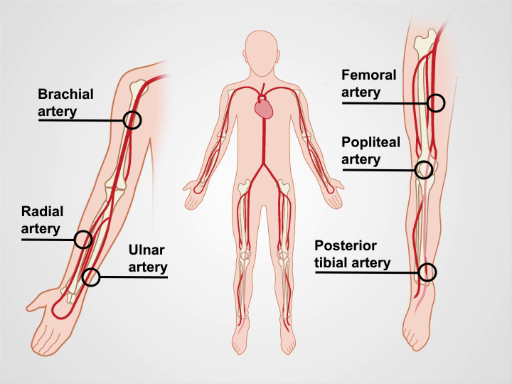Exploración vascular periférica
Visión general
Fuente: José Donroe, MD, medicina interna y Pediatría, Facultad de medicina de Yale, New Haven, CT
La prevalencia de enfermedad vascular periférica (EVP) aumenta con la edad y es una causa importante de morbilidad en pacientes de edad avanzada y enfermedad arterial periférica (EAP) se asocia con complicaciones cardiovasculares y cerebrovasculares. Uso de la diabetes, la hiperlipidemia, la hipertensión y el tabaco son factores de riesgo de enfermedad importante. Cuando los pacientes sintomáticos, se quejan con frecuencia de la claudicación de extremidades, definida como un dolor como calambre muscular que empeora con la actividad y mejora con el reposo. Pacientes con insuficiencia venosa crónica (CVI) a menudo se presentan con hinchazón de la extremidad inferior, dolor, cambios en la piel y ulceración.
Mientras que los beneficios de la detección de pacientes asintomáticos de PVD son confusos, los médicos deben saber la técnica de examen adecuado cuando se está considerando el diagnóstico de PVD. Este video repasa el examen vascular de las extremidades superiores e inferiores y abdomen. Como siempre, el examinador debe utilizar un método sistemático de examen, aunque en la práctica, el grado del examen que realiza un médico depende de su suspicacia de PVD subyacente. En un paciente que tiene o se sospecha que los factores de riesgo para enfermedad vascular, el examen vascular debe ser cuidadoso, comenzando con la inspección, seguida de la palpación y auscultación, y debe incluir maniobras especiales, como determinar el índice braquial de tobillo. Maniobras que hacen uso de un Doppler portátil se han demostrado en un vídeo del compañero.

Figura 1. Las principales arterias de brazos y piernas.
Procedimiento
1. preparación
- Lávese las manos antes de examinar al paciente.
- Que el paciente que se ponga una bata. Este examen no debe ocurrir a través de la ropa.
- Controlar la presión arterial en ambos brazos.
2. las extremidades superiores
- Tener la mentira paciente decúbito dorsal sobre la mesa de examen, con la cabeza levantada en una posición cómoda.
- Comenzar con la inspección al exponer la totalidad de ambos brazos. Observar simetría, color,
Aplicación y resumen
Enfermedad vascular periférica es una causa importante de morbilidad, especialmente en pacientes de edad avanzada. La detección y posterior tratamiento de PVD pueden mejorar la calidad de vida y mitigar potencialmente las complicaciones cardiovasculares y cerebrovasculares. Examen general para la enfermedad vascular periférica de las extremidades no es una recomendación actual por el nos preventivo servicio Task Force (USPSTF). Sin embargo, el USPSTF recomienda exámenes de ultrasonido para aneurismas de la aorta abd...
Saltar a...
Vídeos de esta colección:

Now Playing
Exploración vascular periférica
Physical Examinations I
68.8K Vistas

Abordaje general para la exploración física
Physical Examinations I
117.5K Vistas

Observación e inspección
Physical Examinations I
95.0K Vistas

Palpación
Physical Examinations I
84.5K Vistas

Percusión
Physical Examinations I
101.7K Vistas

Auscultación
Physical Examinations I
62.2K Vistas

Ajuste adecuado de la vestimenta del paciente durante el exploración física
Physical Examinations I
83.4K Vistas

Medición de la presión arterial
Physical Examinations I
108.7K Vistas

Medición de los signos vitales
Physical Examinations I
114.9K Vistas

Exploración pulmonar I: inspección y palpación
Physical Examinations I
157.3K Vistas

Exploración pulmonar II: Percusión y auscultació
Physical Examinations I
212.9K Vistas

Exploración cardiovascular I: Inspección y palpación
Physical Examinations I
176.6K Vistas

Exploración cardiovascular II: Auscultación
Physical Examinations I
140.1K Vistas

Exploración cardiovascular III: Ruidos cardíacos anormales
Physical Examinations I
91.9K Vistas

Exploración vascular periférica con un Doppler de onda continua
Physical Examinations I
38.6K Vistas
ACERCA DE JoVE
Copyright © 2025 MyJoVE Corporation. Todos los derechos reservados